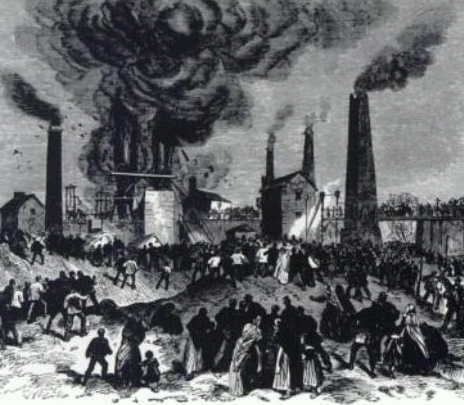Occupation Mining Engineer Name Parkin Jeffcock | Died 1866 | |
 | ||
Parent(s) John and Catherine Jeffcock | ||
Parkin Jeffcock, C.E. (27 October 1829 – 13 December 1866), was a mining engineer who died trying to effect the rescue of miners during the Oaks mining disaster which eventually killed more than 350 people.
Contents
Biography
Parkin was born at Cowley Manor in Ecclesfield, West Riding of Yorkshire, now a part of Sheffield on 27 October 1829, the son of John Jeffcock J.P. (1803–78) and his wife Catherine (1804–72, née Parkin) Lady of the Manor of Darley. He intended to go to Oriel College, Oxford for holy orders, he instead entered an existing college for civil engineers at Putney, which under the presidency of the then Duke of Cambridge and the principalship of the Rev. B.M. Cowrie, was doing good work for that profession. In 1850, after this training at the College for Civil Engineers, he was articled to George Hunter, a colliery viewer and engineer of Durham. He made rapid progress in his profession, and in 1857 he became a partner of J.T. Woodhouse, a mining engineer and agent based in Derby. He moved in 1860 to Duffield, a town just north of Derby.
In 1861, his bravery was noted when he attempted to rescue the men and boys trapped in a coal-pit at Clay Cross during an inundation. In 1863, and again in 1864, he examined and reported on the Moselle coalfield, near Saarbriick. He wrote and delivered a paper on the local minefields to the Institute of Mechanical Engineers in Birmingham. He became a keen member of his local church starting a horticultural society and becoming a church warden. Until 1862, when he resigned his commission he was a Lieutenant in the First West Yorkshire Yeomanry Cavalry.
On 12 December 1866, while at his house at Duffield, he learned that the Oaks Pit, near Barnsley, was on fire. Together with three others, including Mr Smith, an engineer and Mr David Tewart, the steward of the colliery, he descended to make a complete exploration of the mine. They were one of the last parties to enter the mine; previous volunteers had been lost or had abandoned their rescue attempts. One of the party returned to the surface to send down volunteers, but Jeffcock remained below directing the attempted rescue.
Before further help could arrive on the morning of the 13th, a second explosion killed Jeffcock and all but one of the 30 volunteers. The sole survivor was rescued on 14 December 1866 by Thomas William Embleton and John Edward Mannatt. In all 361 people were lost in the incident, including the 29 rescuers. The mine was sealed, and Jeffcock's body was not recovered until 5 October 1867, when it was buried at the Church of St. Mary, Ecclesfield.
Legacy
St. Saviour's church, built as a memorial to Jeffcock at Mortomley, near Sheffield, was completed in 1872, and there is a sizeable (c. 4.5 m) memorial on the Doncaster Road in Barnsley, built in 1913, that commemorates the bravery and sacrifice of Jeffcock and the other rescuers.
Family
Not only was his father and grandfather colliery owners and engineers but so where his three uncles Thomas William Jeffcock, J.P., D.L., Thomas Dunn Jeffcock (an original member of the Yorkshire Geological Polytechnic Society) and William Jeffcock J.P. the first mayor of Sheffield.
Publications
"On the coal and iron mining of South Yorkshire", presented to the Institute of Mechanical Engineers. He noted that the mines employed large steam driven fans that had worked successfully for many years.
